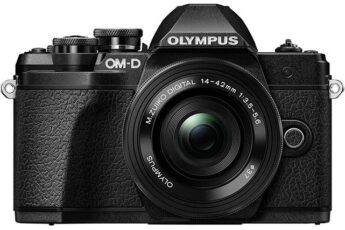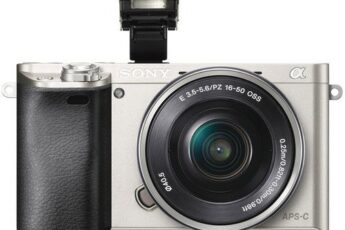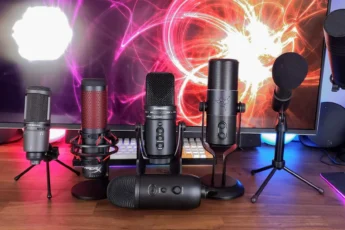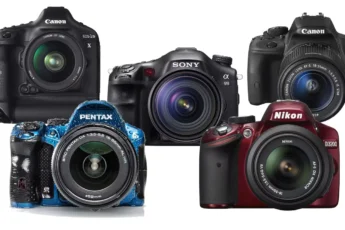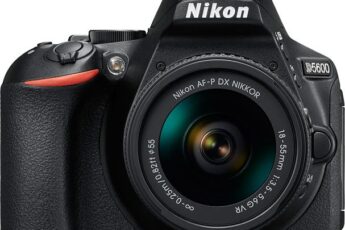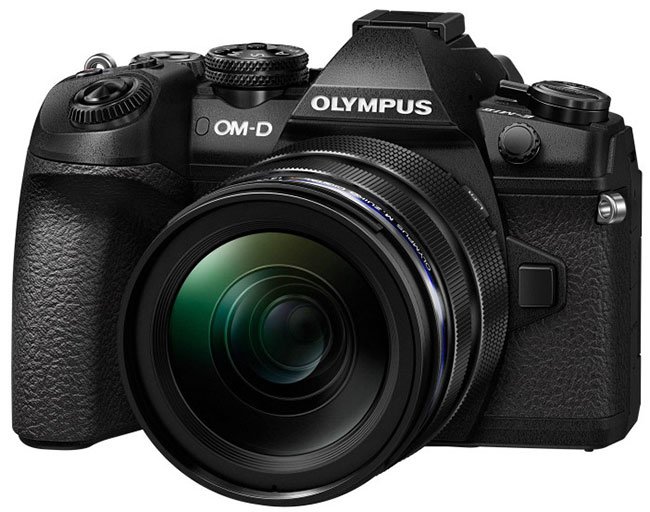
With an MSRP of $1,999.99, the Olympus OM-D E-M1 Mark II is a powerful new addition to the growing line of mirrorless cameras. These cameras are the first major break from the dominant DSLR line of professional grade digital cameras in years and the new system brings powerful new options to the photography world. Is the OMD EM1 Mark II worth the price and learning curve for those new to mirrorless cameras? We’ll help you determine the answer to that question in this review.
Low on time and ready to buy?
- Technical Specifications
- Build Quality
- Image Quality
- What is the benefit of the Mark II’s Hybrid AutoFocus System?
- Advanced Shooting Modes available to the Mark II
- How do Mirrorless cameras compare to DSLR cameras?
- Mirrorless advantages compared to DSLRs
- Mirrorless disadvantages compared to DSLRs
- How does the Olympus OM-D E-M1 Mark II compare to the Mark I?
- How does the OMD EM1 Mark II compare to the Panasonic Lumix DC-GH5?
- Final Thoughts
Technical Specifications
- Sensor: The Mark II’s 20.4 MP sensor is sized at 17.3mm x 13mm, making it a “micro four-thirds” sensor with a 2x crop factor. This doubles the effective focal length of any lens you use, turning a 50mm to a 100mm if you were using 35mm film (or a full-frame DSLR sensor). Smaller sensors help keep the size of the camera down as well.
- Number of Autofocus Points: 121. The Mark II uses a hybrid point AF system, which we will explore in depth below. 121 autofocus points is a huge amount compared to DSLRs and a great feature for any camera.
- Kit Lens: The Mark II does not come with a kit lens, however dozens of lenses from a wide variety of manufacturers currently exist for this camera.
- Built-in Flash: No built in flash. It does come with an FL-LM3 external flash unit and a hot shoe to power it or any other external flash.
- Continuous Shooting: The Mark II can shoot up to 60 fps (Electronic shutter) and 15 fps (Mechanical shutter). When using the electronic shutter and continuous autofocus, the camera can shoot up to 18 fps. The high continuous shooting speed is incredibly useful for sports photography when you know a great pose is coming, but not exactly when.
- ISO Range: Native ISO 200-25,600 (with digital boosting down to ISO 64)
- Video Recording Capability: The Mark II can take 4K video in Ultra HD format (3840 x 2160) up to 30 fps and Cinema 4K (4096 x 2160) at 24 fps, making it an excellent camera for video.
- Image Format: JPEG, RAW, and JPEG + RAW with the same exposure. The Mark II also has a “High Res Shot” mode for ultra-high resolution 50 MP JPEG images.
- Battery Life (CIPA rating): 440 shots per charge
- Storage: Accepts SD, SDHC, SDXC, and Eye-Fi memory cards. There are 2 memory card slots for double the storage capacity. Slot 1 is UHS-I and UHS-II (Ultra High Speed) bus compatible. Slot 2 is only UHS-I compatible.
- Weight: 574 g (1.27 lb. / 20.25 oz.)
- Dimensions: 134.1 x 90.9 x 68.9 mm (5.28 x 3.58 x 2.71 in.)

Build Quality
The Olympus OM-D E-M1 Mark II uses a premium magnesium alloy construction for its body. Magnesium alloy is used in most higher end cameras due to its corrosion resistance and lightness compared to other metals. The body is weather-sealed and freeze-proof down to 14℉ (-10℃). The weather sealing also prevents dust and splashes of water from affecting the camera. You should still avoid submerging the camera.
A major advantage of the Mark II is that it has no need for a complex system of internal mirrors. Nor does it have a dedicated phase detection autofocus system (discussed further below). This saves space and allows for the body size to be greatly reduced in comparison to DSLR cameras. Most mirrorless cameras fit quite neatly into a pocket without the lens. They are great walkaround cameras without sacrificing image quality.
Image Quality
The OMD EM1 Mark II features a 20.4 megapixel sensor, which at first feels surprisingly low for this price bracket. However, given the smaller sensor, too many pixels on the sensor would actually cause interference issues and be problematic. And it’s worth noting that unless you plan on making huge prints, anything over 20.4 megapixels is not as useful as it sounds. A four thirds sensor is roughly a quarter the size of a full-frame sensor and has a 2x crop factor. The sensor is still larger than that of a point-and-shoot type camera but significantly smaller than either an APS-C or a full-frame sensor.
A larger sensor can house larger pixels, which collect more light over a larger area. With its smaller sensor, the Mark II will suffer slightly compared to a full-frame sensor, depending on lighting levels, lenses used, and the skill of the photographer. To explain it differently, the OM-D E-M1 Mark II is not as forgiving of less than perfect shooting technique due to the smaller amount of light being collected. But if your settings are optimal for the scene, then you will not suffer in image quality in the slightest. 20.4 megapixels and a four-thirds sensor are plenty for an excellent image resolution. And given the huge amount of advanced tools the Mark II has at its disposal, your images should never be anything less than excellent with this camera.
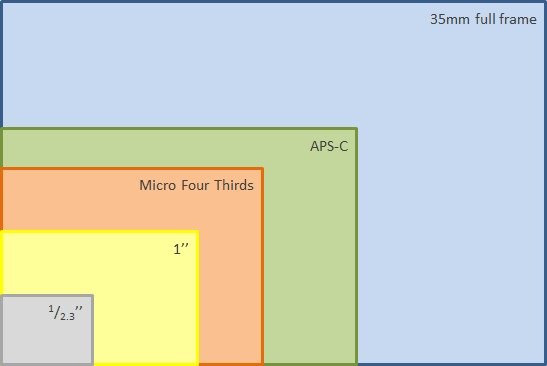
A comparison of sensor sizes.
What is the benefit of the Mark II’s Hybrid AutoFocus System?
The autofocus system on the Olympus Mark II is extremely impressive. It’s worth discussing the three types of AutoFocus standard in digital photography to better understand what the Mark II has to offer. Keep in mind, this will be a large simplification of rather complex systems for easy understanding of why Hybrid AF is so powerful.
Phase Detection, which nearly all DSLRs have, uses two sets of mirrors. The first mirror is semi-silvered, and sends most of the light up into the pentaprism, which sends light further to the viewfinder, where you see your subject. However, some of the remaining light is sent to dedicated phase detection autofocus sensors at the bottom of your camera, separate from your image sensor. There are two phase detection AF sensors for every focus point your camera has. The phase detection AF system compares the images from each pair of AF sensors to determine if the focus of each aligns. If not, then the sensor instructs the lens to adjust until the phase pairs keyed to each AF point aligns properly. Compared to Contrast Detection, Phase Detection is very fast, as the sensor uses preloaded image data within the camera’s firmware to know how the image should appear.
Contrast Detection uses a processor to directly analyze the image obtained by the image sensor as the lens moves to determine peak focus (the most contrast). This system will usually “hunt” around by creeping from out of focus, briefly hitting perfect focus, overshooting slightly, and then returning to the optimal focus previously detected. Thus, moving subjects can give Contrast Detection AF systems a headache if the depth of field is too shallow. Contrast Detection is slower but more precise than phase detection, as the latter involves a series of parts in precise alignment that can rather easily be disturbed and rendered inaccurate. Contrast Detection is used by smartphones, mirrorless cameras, and any DSLR with a Live View panel that you can shoot from.
Our Olympus Mark II has 121 “on-chip” phase detection sensors (AF points) covering 75% of the image sensor. Being mirrorless, these points are used in pairs to measure the distance from subject to sensor. This determines autofocus similar to how a mirror-using phase detection system would on a DSLR. Once the camera has approximated focus, it then switches to using contrast detection to fine tune image sharpness. In summary, the camera neither needs space consuming mirrors, nor does it need to hunt around a large range, like a pure contrast detection AF system would.
The Olympus Mark II also has an AF Limiter function as a menu option. You can choose one of three preset distances and the camera will only attempt to hunt for focus within that range. The ranges are also fully customizable, giving you one of the fastest and most advanced AF systems money can buy!
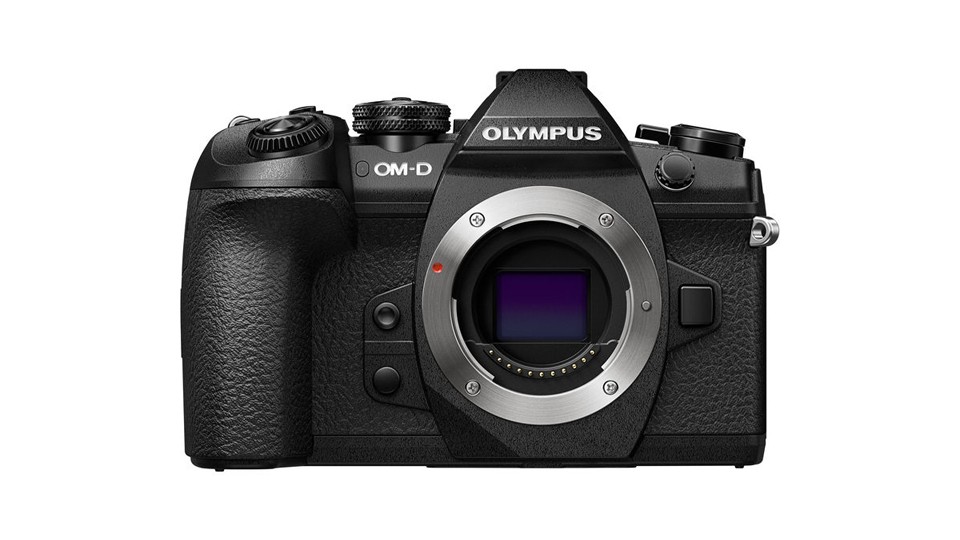
Advanced Shooting Modes available to the Mark II
The has some incredible options for the savvy photographer looking to apply advanced software and processing effects in-camera. One option is a powerful 50 megapixel JPEG or 80 MP RAW “High Res Shooting” mode. The camera moves its sensor by half a pixel in four different directions, taking 8 photos, and then stitches them together in-camera for an ultra-high resolution photo. But because the Mark II is taking 8 consecutive shots, High-Res mode will result in unacceptable blur if the subject or major elements in the scene are moving. A flag waving in the wind, rapidly changing light conditions, or fast action will not create a good image in this mode.
The Mark II does have in-camera image processing to counteract this, but it works best for slow moving subjects, such as wind moving leaves slightly. It takes about 1 second using the Mark II’s electronic shutter to take the series of images, and another 2-3 seconds to process the final image. The 1 second shooting time and moving sensor also require a tripod when using this mode to avoid problems caused by hand shake. ISO cannot exceed 1600 in this mode, nor can an aperture smaller than f/8 be used.
Another option is Silent Mode for the polite street or wedding photographer, or any would-be successful nature photographer. The Mark II switches from using a physical shutter to an electronic one, which also allows the camera’s shutter speed to go from a max 1/8,000th of a second to 1/32,000th of a second. There may be some noise from the lens focusing, but no tell-tale click to spoil the moment. In certain situations, there is a slight loss of dynamic range from switching to e-shutter, and so the Mark II retains both shutter options.
The physical and e-shutter combination also allows for Pro Capture Mode, which when activated, allows the shooter to hold the shutter down halfway. While waiting for that moment of perfect action to occur, the camera begins taking images in the background and buffering them to memory. Then, after taking the image you intended with the physical shutter, you can either release the shutter or keep it pressed down to take even more images in case you pressed too early or expect another moment.
One of the most exciting options is Focus Stacking mode, another option where a tripod is required for best results. The camera takes several images, adjusting the depth of field slightly with each image, and then merges the images into a single image with sharp focus across the subject. For macro and portrait photographers especially, Focus Stacking is an amazing tool for getting crisp detail from a subject using an otherwise tight depth of field that might cause unfortunate blurring in sections.
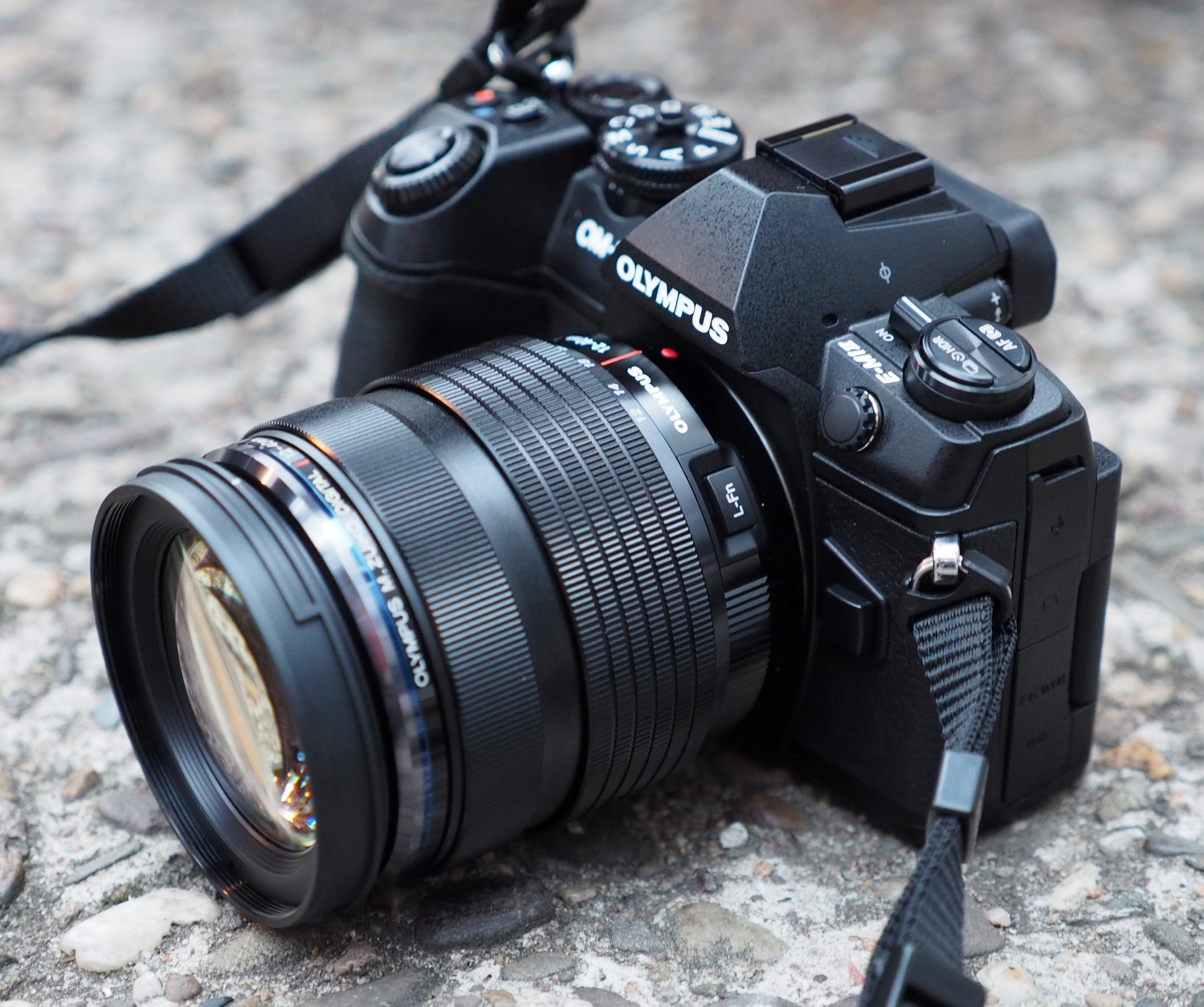
How do Mirrorless cameras compare to DSLR cameras?
Mirrorless advantages compared to DSLRs
Smaller: Naturally, a mirrorless cameras does not have mirrors within the body, which means space normally used to house those components can be eliminated. This also eliminates the need for a viewfinder. Mirrorless cameras tend to be pocket-sized. DSLRs are generally worn around the neck and can be obtrusive and bulky-feeling. However, mirrorless cameras are comparable in weight to most DSLRs.
Hybrid AF: As explained above, Hybrid AF is much faster than either Phase or Contrast Detection. Most of the newest mirrorless cameras employ some version of this technology and boast far more AF points than the newest DSLRs.
Mirrorless disadvantages compared to DSLRs
Smaller sensors: The four thirds sensors used by nearly all mirrorless cameras are smaller than the APS-C and full-frame sensors used by DSLRs. Smaller sensors collect less light for the final image composition. As a result, if you happen to take a photo using ISO 500 when 800 would have been better, the resulting dimness will look even poorer as there’s less light information available to begin with. But this is a function of sensor size, not an inherent flaw of DSLR vs. mirrorless technology. A number of APS-C and full-frame mirrorless cameras exist, though not nearly as many as there are DSLRs.
Smaller Batteries: With only 440 shots compared to double or even triple that number on the large-bodied DSLRs, a battery grip or extra batteries are absolutely mandatory with a mirrorless camera. A single outing might tax your battery to its limit.
Available lenses: The OM-D E-M1 Mark II has dozens of lenses that are compatible with its body, but that pales in comparison to the 400+ available to anyone using Nikon’s F-mount lenses. Given time, this gap will definitely narrow. Also, with the right adapters, you can connect many of your old Canon or Nikon lenses to your mirrorless camera. Keep in mind that an adapter usually won’t allow the autofocus abilities to operate, so you’re stuck using manual focus. But this is a great way to get additional mileage out of a large collection of lenses that might keep you from wanting to switch to mirrorless technology.
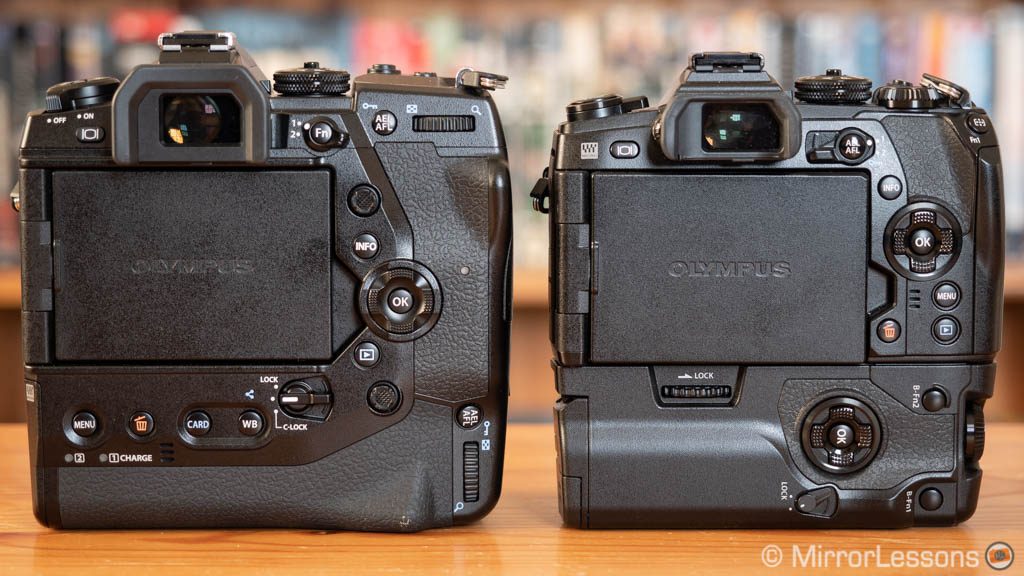
Olympus OM-D EM-1 Mark II with a powered grip
How does the Olympus OM-D E-M1 Mark II compare to the Mark I?
The OM-D E-M1 Mark II is a significant upgrade over the Mark I. To start, the Mark I has 16 megapixels, compared to the 20 offered by the Mark II. The AF system of the Mark I consists of 81 contrast points and 37 phase detection points, in a near-hybrid fashion, but not the true 121-point hybrid system of the Mark II. The e-shutter of the Mark I is as fast as 1/16,000th of a second, which is half as fast as the 1/32,000th of a second of the Mark II.
The Mark I does not offer High Res Shot mode, but does offer Focus Stacking. The USB 3.0 slot of the Mark II allows for 5 GBits/sec of data transfer over the slower USB 2.0 slot of the Mark I (480 MBits/sec). However, the Mark I does weight approx. 15% lighter than the Mark II.
The Mark II is a clear upgrade over the Mark I. Also, the processor speed is significantly improved. This affects everything; not just standard shooting and buffering of images, but especially the advanced shooting modes like focus stacking. The Mark I has many of the same features, but the Mark II will perform these same tasks much quicker.

How does the OMD EM1 Mark II compare to the Panasonic Lumix DC-GH5?
The major competitor to the OM-D E-M1 Mark II is the Panasonic Lumix DC-GH5, another mirrorless camera in the same price bracket with comparable features. With the same MSRP of $1,999.95, sensor size, megapixel count, weatherized magnesium body, and native ISO, the cameras are definitely on a level playing field. As it turns out, the differences are quite minimal and it simply depends on which features are most important to the buyer.
Weight: The GH5 weighs in at 725 g (1.60 lb / 25.57 oz), significantly heavier than the Mark II at 574 g (1.27 lb / 20.25 oz)
Buttons: The GH5 has 20 buttons for instant access to various features. The Mark II has 9, which means the menu will have to be navigated occasionally.
LCD: The Live Viewfinder resolution of the GH5 stands at an impressive 3,680,000 pixels, compared to the 2,360,000 pixels of the Mark II.
Continuous Shooting: The Mark II is a clear winner here, with 60 fps solidly beating out the 12 fps of the GH5.
AutoFocus: Rather than using a hybrid system, the Panasonic GH5 uses purely contrast detection, known as Depth from Defocus technology. The GH5 brings 225 AF points to bear, but Contrast Detection AF is naturally slightly slower and has difficulties with moving subjects and shifting lighting situations.
Final Thoughts
The OM-D E-M1 Mark II is an excellent intermediate to advanced level camera that has taken the rapidly maturing mirrorless technology to a powerful new standard. It offers everything a DSLR user would expect at this price bracket. Also, its powerful integrated shooting modes allow for exceptional edits that previously required additional hardware and software to duplicate (like Focus Stacking). The Mark II is well worth the price tag, and Digital Camera Central rates this camera as a must-see for anyone considering upgrading from the Olympus OM-D E-M1 Mark I or even a first-time mirrorless camera user!
Is this the camera for you?

